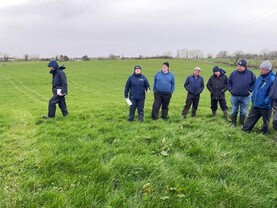The finishing heifers and bullocks on the Irish Farmers Journal Thrive demonstration farm in Cashel, Co Tipperary, have been housed over the past few weeks.
Housing began on 8 October for the Belgian Blue bullocks. They were showing no sign of fleshing at grass, so the decision was made to house them and increase the level of meal feeding to 6kg/day.
On 15 October, a batch of heifers and a batch of bullocks were housed. These were cattle that were not going to be drafted for slaughter in the last 10 days to two weeks of what was left of the grazing season.
A further two batches of bullocks and heifers were housed on 26 October for finishing.
Draft assessment
On Wednesday 4 November, all housed cattle were weighed and assessed for drafting for slaughter. From this draft, nine bullocks and four heifers were identified for slaughter early next week.
Looking at the drafted bullocks, eight of them had been housed on 15 October, as well as drafting the first Belgian Blue bullock of the year. The heifers drafted were all from the batch housed on the same date as the bullocks.
It was very obvious that the earlier-housed batches had kicked on again in terms of thrive, while those that were just housed with 10 days were still finding their feet.
In fact, many of the heifers housed on the 26 October were the same weight on 4 November.
Transition to housing
This period of poor or non-performance will not come as a surprise to farmers, as it is typical of what happens when you house cattle. The question is, how do we minimise this check in growth?
The biggest thing that changes from outdoors to indoors is the diet. The fact that the cattle were being fed concentrate at grass prior to housing will have helped to minimise the transition.
This meal feeding was maintained to heifers at a rate of 3kg/day and to bullocks at 4kg/day (apart from Belgian Blue bullocks). However, the basal diet still had to change from grass to grass silage. While this may seem only a small difference, it still takes the animals’ digestive system time to adjust.
Even where grass silage quality is excellent, the total fibre content of the diet will have increased
There will also be a gut fill and passage rate changes happening within the animal. They are going from a low fibre grass diet to a higher fibre silage diet.
Even where grass silage quality is excellent, the total fibre content of the diet will have increased. This can slow the movement of feed through the animal and can have a short-term negative effect on liveweight gain.
Stress
Minimising the stress on animals at housing will also help minimise any growth check. Make sure animals are not overcrowded in pens, have constant access to top-quality silage and fresh clean water and avoid housing in too big of groups.
Cattle have a social hierarchy among the group, meaning that everyone in the group knows their place.
The larger the group, the more social interactions there are between each animal in the group, which means it takes longer for them to sort out the social standing.
Smaller groups can sort this quite quickly and everyone knows where they stand.
For steers and heifers, groups of up to 30 should be fine. In the case of young bulls, try to keep group size to a maximum of 10.






 This is a subscriber-only article
This is a subscriber-only article










SHARING OPTIONS: